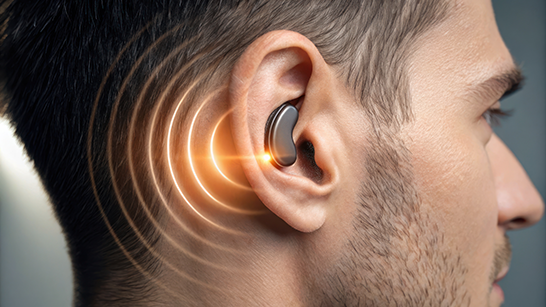What Do Hearing Test Results Mean?: The silent clues your test reveals about your hearing health
A hearing test is a good way to learn more about the health of your ears. The test shows if you have hearing loss, like mild hearing loss, or if there may be something wrong in the middle or inner ear. A hearing test helps you see how well you hear sounds. During the test, you listen to sounds with different frequencies to find your hearing thresholds. This shows you the state of your hearing and helps you know if you need a hearing aid or any other help. When you know your hearing test results, you can take action. This can make your life better.

Stay with us. We will tell you more about how a hearing test works. We will also explain how you can read your hearing test results.
Understanding Your Hearing Test Results
Hearing test results identify the type and severity of hearing loss. Audiograms chart your hearing sensitivity, while speech audiometry shows how clearly you understand speech. Tests such as air and bone conduction measurements help determine whether your hearing loss is conductive, sensorineural, or mixed.
The Basics of Audiograms: What They Show
An audiogram is a graph that displays your hearing thresholds—the softest sounds you can hear—across different frequencies (pitches) and intensities (loudness in dB HL).
- The horizontal axis shows frequency, from low to high pitches.
- The vertical axis shows sound intensity in decibels (dB HL), with lower points meaning louder sounds needed to hear.
During the test, you’ll wear headphones or bone conduction de
What Do Hearing Test Results Mean?
Normal hearing typically ranges from -10 to 20 dB HL. Thresholds above this indicate some degree of hearing loss. Patterns in the graph—like drops at certain frequencies—help audiologists identify the type and severity of hearing loss and guide treatment decisions.
Decoding Symbols and Lines on the Audiogram
Symbols and Their Meanings in Audiometry
| Symbol | Ear/Test Type | Meaning |
| “O” | Right Ear (Air) | Air conduction threshold (right) |
| “X” | Left Ear (Air) | Air conduction threshold (left) |
| “[” or “]” | Bone Conduction | Bone conduction thresholds |
| △ or ◼ | Masking | Indicates masking was used |
A flat line near 0 to 20 dB HL usually means normal hearing. Dips indicate specific types of hearing loss patterns like age-related or noise-induced hearing loss.
What is normal hearing range?
Normal hearing is when you can hear sounds between 0 and 25 decibels (dB) .
This helps people notice soft noises and also understand speech in quiet or loud places.
Hearing loss is classified as:
| Degree | Threshold (dB HL) |
| Normal | 0–25 |
| Mild | 26–40 |
| Moderate | 41–55 |
| Moderately Severe | 56–70 |
| Severe | 71–90 |
| Profound | 91+ |
What types of hearing tests measure hearing ability?
Hearing ability is assessed using several key tests:
- Pure-tone audiometry: Measures the quietest sounds you can hear at different frequencies.
- Speech recognition tests: Evaluate how well you understand spoken words.
- Tympanometry: Checks eardrum movement to detect issues like fluid buildup, eustachian tube problems, or perforated eardrums.
- Bone conduction tests: Assess inner ear function by bypassing the outer and middle ear.
Together, these tests give a complete picture of your hearing health.
What Does an Audiogram Show?
An audiogram charts your hearing thresholds across frequencies. It reveals the softest sounds you can hear and identifies hearing loss severity and type. This helps audiologists recommend the best treatment options for you.
What Is Tympanometry and What Does It Diagnose?
Tympanometry measures eardrum movement in response to air pressure changes. It diagnoses middle ear problems such as fluid buildup, eustachian tube dysfunction, or eardrum perforations. This test is crucial for understanding ear health beyond hearing sensitivity.
How Do Bone and Air Conduction Tests Differ?
- Bone conduction tests bypass the outer and middle ear to directly assess inner ear function.
- Air conduction tests evaluate hearing through the entire ear pathway (outer, middle, and inner ear).
Comparing these tests helps identify whether hearing loss is conductive (outer/middle ear issue) or sensorineural (inner ear issue), guiding appropriate treatment.
Types of Hearing Loss Revealed by Tests
Hearing tests identify different types of hearing loss, including sensorineural and conductive. Sensorineural hearing loss occurs when the inner ear or auditory nerve is damaged, often causing permanent hearing loss. Conductive hearing loss occurs when problems in the outer or middle ear prevent sound from passing through, without affecting the inner ear. Mixed hearing loss occurs when both types of hearing loss occur simultaneously, causing issues with sound transmission and inner ear function. Audiograms help audiologists determine the type of hearing loss and determine the most effective hearing care plan for the individual.
Conductive vs Sensorineural Hearing Loss
Conductive hearing loss occurs when sound waves have trouble passing through the outer or middle ear. Causes include earwax buildup, eardrum damage, or infections. It often makes sounds seem quieter but doesn’t affect the inner ear.
Sensorineural hearing loss happens due to damage in the inner ear or auditory nerve. This type affects how sound signals are sent to the brain, making it hard to understand speech, especially in noisy places.
Audiograms help differentiate these types:
- In conductive loss, bone conduction scores are better than air conduction, showing a gap.
- In sensorineural loss, air and bone conduction scores are similarly reduced.
Knowing the difference is key for choosing the right treatment and hearing aids.
What High Frequency Hearing Loss Looks Like
High-frequency hearing loss is a condition that makes it difficult to hear certain parts of human speech, particularly soft sounds like consonants. This can be caused by prolonged exposure to loud noise, aging, or medical issues. People with this type of hearing loss often struggle to understand others’ speech due to noise. Speech audiometry or pure tone threshold tests can help identify weaker hearing in higher frequencies. This type of hearing loss can make it difficult for individuals to participate in group talks and understand others’ words. Early detection and treatment with hearing aids or special listening practices can help manage this type of hearing loss, making it easier to talk and listen, and ensuring good hearing health.
Impact of Hearing Loss on Daily Life
Hearing loss affects many areas of daily life, including communication, safety, and social well-being. Here’s how it can impact you:
Communication Challenges
- Difficulty understanding speech, especially in noisy environments
- Trouble following group conversations
- Missing important speech cues or tones
Social Effects
- Feeling isolated or left out in social gatherings
- Reduced confidence in conversations
- Strained relationships due to misunderstandings
Work and Safety Concerns
- Missing important work instructions or alerts
- Increased risk of accidents due to not hearing warnings
- Lower job performance in noise-sensitive environments
Emotional and Mental Health
- Frustration and stress from communication barriers
- Increased risk of anxiety or depression
- Feeling disconnected from family and friends
Recognizing these impacts early can help you seek the right treatment and improve your quality of life.
Challenges in Conversations and Social Interactions
Hearing loss can make everyday communication difficult, especially in noisy places.
Key challenges include:
- Difficulty Hearing Speech: Soft sounds and certain speech parts become hard to catch.
- Background Noise Interference: Noisy environments make it tough to focus on conversations.
- Feeling Left Out: Struggling to follow group talks can lead to social withdrawal.
- Increased Effort: You may need to concentrate harder to understand speech, causing fatigue.
Using hearing aids and other assistive tools can help improve communication and maintain social connections.
Effects on Work Performance and Safety
Hearing loss affects not only personal life but also work, as it can lead to missed important sounds or conversations, especially in jobs like construction or customer service. Good hearing is crucial for completing tasks accurately and ensuring safety. Lower hearing thresholds can make it difficult to hear alarms, instructions, or alerts, potentially leading to accidents. Speech testing can help identify which sound ranges make work harder for individuals. To address these issues, hearing aids or quick steps to improve hearing can be helpful. Audiometric tests can provide insight into hearing loss at work, allowing individuals to make necessary adjustments to improve their hearing and work performance, ultimately ensuring safety and productivity in the workplace.
Treatment Options Based on Hearing Test Results
Your hearing test results guide the best treatment for your hearing loss. Treatment options include:
- Over-the-Counter (OTC) Hearing Aids: Suitable for mild to moderate hearing loss (usually up to 60 dB HL). Easy to access and use for daily needs.
- Prescription Hearing Aids: Recommended for more severe or complex hearing loss. Custom-fitted by audiologists with advanced features for clearer speech.
- Surgical Interventions: For severe cases, surgery such as cochlear implants or procedures to fix middle ear issues may be necessary.
- Medical Treatments: Medicines may be prescribed to treat infections or fluid buildup affecting hearing.
Early diagnosis and tailored treatment can improve hearing and quality of life. Always consult a hearing professional for personalised advice.
When to Consider Hearing Aids
Hearing aids can greatly improve quality of life for many people with hearing loss. Here’s when you should consider them:
- Mild to Moderate Hearing Loss: Over-the-counter (OTC) hearing aids can help if your hearing loss is less than 60 dB HL and fairly even in both ears.
- Uneven or Complex Hearing Loss: Prescription hearing aids are better suited for those with different hearing levels in each ear or sensorineural hearing loss.
- Difficulty Understanding Speech: If you struggle to hear conversations, especially in noisy environments, hearing aids with advanced speech programs can help.
- Improving Social and Work Life: Hearing aids can boost communication, confidence, and safety both socially and professionally.
Consult an audiologist to find the right type and fit for your specific hearing needs.
The Role of Surgery and Other Medical Interventions
Sometimes, hearing loss requires more than just hearing aids. Medical treatments and surgeries can help restore or improve hearing, depending on the cause and severity. Common interventions include:
- Cochlear Implants: Devices implanted to help those with severe inner ear damage who don’t benefit from hearing aids.
- Stapedectomy: Surgery to fix otosclerosis by replacing a stiffened bone in the middle ear.
- Tympanoplasty: Repair of a perforated eardrum to improve sound transmission.
- Medication: Used to treat infections or reduce fluid in the middle ear affecting hearing.
- Other Procedures: Treatments tailored based on audiometric tests, such as addressing Eustachian tube dysfunction.
These interventions are guided by hearing test results and audiologist recommendations to provide the most effective care.
What does a flat audiogram indicate?
A flat audiogram indicates a consistent hearing loss at every sound level, often due to air conduction issues like infection or middle ear problems. The sound’s path does not change, indicating that sound is not passing through the ear properly. This type of hearing loss often requires assistance or treatment.
How often should I get my hearing tested?
Hearing tests are recommended for adults every few years, while young children and those in noisy environments should have them more frequently. In the United States, some jobs require workers to undergo a hearing test due to noise exposure, ensuring their hearing safety.






